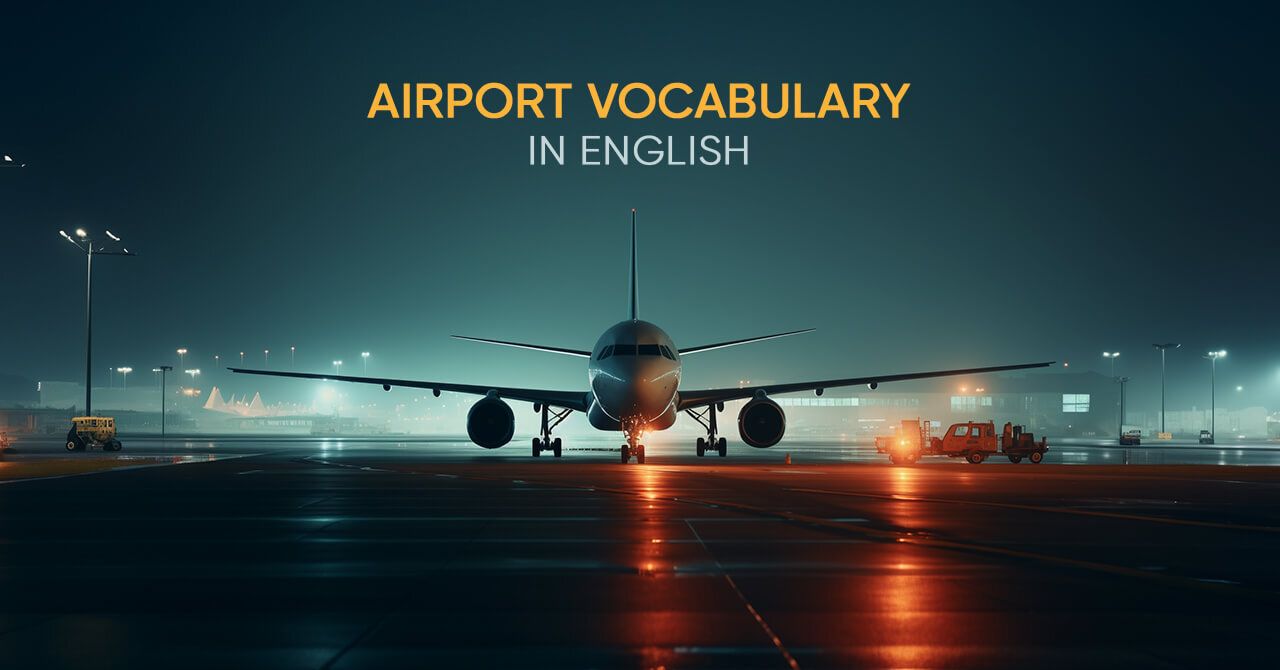
Navigating the Airport: Discover Unique Airport Vocabulary
Yeah, there are so many reasons why airport vocabulary matters. One of them is to ensure clear communication at the airport to avoid confusion and delays.
Traveling to another country is often exciting. But it can be both fun and challenging, especially if you’re not familiar with airport vocabulary and phrases.
Learning unique airport terminology now would be a great decision. You could save time and have less stress when you finally travel abroad.
Words such as boarding time, final call, concourse, gate, et cetera can leave you wondering what they mean. And they are not always going to be written or announced in your native language.
Luckily, I’ve mentioned nearly everything you need to know about airport language today, so please sit tight and get the most out of the following information.
Unlock the “at-the-airport-vocabulary” for travelers
Yeah, there are so many reasons why airport vocabulary matters. One of them is to ensure clear communication at the airport to avoid confusion and delays.
Please pay attention now and see why understanding airport language can be beneficial to you or anyone you know who might be planning to travel abroad.
Introduction to airport language: Booking a flight
This is where it all starts. We can also say buying a ticket.
The word “flight” represents the aircraft or airplane (or aeroplane as the British also call it) that would bring you to your destination. So, if you want to take a plane, you must “book a flight” (or buy a ticket) first.
While you are “buying a ticket,” note that there are a few details you need to consider. The first is whether you’re buying a one-way ticket or a round-trip ticket.
Let’s find out the difference between these two types of airline tickets in a nutshell.
One-way ticket
In brief, one-way tickets only allow you to fly from wherever you are to your destination. For example, you could fly from Kenya to Ukraine, the land of heroes, or from China to Egypt. Do you get the point?
Round-trip ticket
Unlike one-way tickets, these ones allow you to fly to your destination and back to where you started like flying from Kenya to Ukraine and back.
Another thing to consider is the airline and your airfare.
An “airline” is simply the company that flies the aircraft (or plane) that would fly you to your desired destination. You will most likely hear people using the word “fly” followed by the name of an airline.
When traveling from Nairobi to Cape Town, for instance, I’d prefer to fly Qatar Airways, Qatar’s flag carrier. I may also fly KQ Airways to promote Kenya’s number-one airline company.
Meanwhile, as with “bus fare,” “airfare” is simply the value of an air ticket. I mean the amount of money your ticket costs, in other words.
Airport check-in terminology
Let’s now learn about check-in procedures and other related airport phrases, such as boarding passes, baggage allowance, gate assignment, etc.
The check-in process is often the first thing to do at the airport. It’s typically the first step on your journey.
Being familiar with the airport words or terms often used during check-in will let you experience a smoother and less confusing process. Below, I’ve explained some common airport check-in terms you may find helpful.
Boarding pass
Don’t mistake it for the one you got when you booked your flight. A “boarding pass” is a different document they give you at the airport during check-in. It’s what allows you to enter the “restricted area” and finally board the aircraft.
Baggage allowance
This is simply the amount of baggage (or luggage) you are allowed to bring on the flight. It usually depends on the airline’s baggage policy.
There are limits on the amount of baggage you can bring for free (and hard limits the airline allows). And the limit is often based on the total weight of all your luggage.
That means you can bring as many bags on the plane as you like. But that’s as long as it doesn’t exceed the baggage (or weight allowance) for your travel class. Each bag should weigh no more than 32kg.
Security screening
In brief, airport security screening is the process of checking passengers and their personal belongings (including their carry-on bag) to ensure the safety of everyone in the terminal.
Usually, it’s to check whether you brought any items that are considered dangerous. These would be things such as chemicals, liquids, knives, and so on.
Moreover, the airport’s Transportation Security Administration (TSA) will use screening equipment like millimeter wave machines, metal detectors, backscatter X-rays, and cabinet X-ray machines to detect prohibited items.
Customs and immigration
In brief, customs and immigration are checkpoints that you must pass before you leave the airport, especially when you’re visiting another country.
The difference between these two, however, is that immigration (or border control) is about the traveler who’s entering another country. Meanwhile, customs is about the baggage or items you carry with you.
The process involves speaking with the officers in charge of immigration and customs, who would stamp your passport to indicate that you’re good to go.
Baggage tag
Also known as luggage tags, they are small pieces of identification attached to your bag(s) to track the baggage to its final destination. They often contain details of your flight and destination for easy tracking.
Moreover, baggage tags also help distinguish your luggage from other bags that may look similar. For that matter, they also contain details of the traveler, such as your name and contact details, which helps a lot in case you lose your baggage.
Airport phrases for security procedures
Just as I’ve mentioned above, you will be asked similar questions when you go through security to ensure the safety of everyone:
“Would you kindly take off your shoes and put (or place) them in that bin?”
Some shoes may have metal on them, which can easily trigger the alarm system on metal detectors, causing unnecessary delays during check-in.
“Remove all electronics from your luggage.”
Electronics can also set off the alarm, so you need to comply and let the security personnel scan them separately to make sure they are safe to bring on the aircraft.
“Mind you walk through the metal detector, sir/mum?”
That’s the main airport security screening right there. They use it to detect any presence of metals. You may be required to undergo additional screening when it goes off.
What are some effective ways to practice English airport vocabulary?
I can recommend a few ways I know can help you learn the airport language quickly.
You can practice with the LiveXP Word Trainer, which is designed to help you practice challenging words in almost any language. The tool is essentially one of the most effective practical ways to memorize the words, learn how to pronounce them correctly, and use them in context. You have access to the exercises from your smartphone. So, you can practice anywhere and at any time. The LiveXP app will remind you when you need to refresh your vocabulary, as the Word Trainer feature works in a spaced repetition algorithm. This ensures the most effective memorizing process.
If you already memorized some airport vocabulary and want to practice with native speakers before going to the airport, LiveXP has tutors who can help. In 1-on-1 lessons with any English tutor on the platform, you can practice using new words and phrases in real-life conversations. Tutors are always available to help you understand common airport phrases and answer all check-in-related questions promptly.
Common airport words for terminals and gates
While at the airport, knowing your way around the terminals and understanding gate terminology can make your travel experience less stressful. Let’s now see what it means when you see or hear the following airport words:
Concourse
Think of them as hallways in the airport terminal. Concourses are designed to house gates, shops, restaurants, and seating areas.
They are often labeled with letters, such as Concourse A (gates A1–20), Concourse E (E60–69), etc., to help travelers easily find their way around the airport.
For instance, assuming you were trying to find gate E62, you would need to follow the directions to Concourse E and then head to gate number E62. I’ve mentioned what the “gates” at airports are a little further below.
Departure lounge
This facility is available at many airports. After you’ve checked in, you wait before boarding the plane.
These lounges provide amenities and services to make your pre-flight more comfortable and convenient. Additionally, departure lounges often vary in size (and amenities) depending on factors such as the airport and/or airline.
But they generally provide features such as a more comfortable seating space, food and drinks, priority boarding, and free Wi-Fi, to name a few.
Gate
When you hear of gates, it means the airport terminal or section controlling plane access.
Although the exact specification may vary from country to country (or from airport to airport), most “gates” have a departure lounge, a counter, and a doorway that leads to the plane. And they are often labeled with letters, numbers, or both.
For example, gate A1, D20, E62, and so on. Just as I mentioned above, gates are often located within the concourse, the hallways in the airport terminal.
These hallways (or concourses) are also marked by letters and gate numbers to make it easier for travelers to find their designated gates.
Boarding time
After you are done with security screening during airport check-in, you will notice two times on your issued boarding pass: the “boarding time” and the “departure time.”
What’s the difference between these two times, you may wonder?
Here’s the thing: the “boarding time,” which is basically the time when you are expected to start boarding the passenger aircraft.
Meanwhile, the “departure time” is the time when your flight is expected (or otherwise scheduled) to take off. In other words, all passengers at this point should be safe inside the aircraft, seated, and ready to fly.
Final call
What do they often mean when they announce the “final call” at the airport?
Well, it’s just as simple and straightforward as it reads or sounds—the final call. It’s typically the last warning (or last opportunity) you have to board the aircraft. And there’s not much to say about it.
However, the announcement of the final call is often made when there are only a few minutes left (about 5 to 10 minutes) for the plane to leave the gate and take off.
Arrivals hall
The “arrivals hall” is where you are directed once you get off the plane. The place serves as the first point of contact when you reach your destination.
It facilitates the efficient movement of passengers from the plane (or aircraft) to the terminal building, where you can now proceed to customs and immigration. Keep going to learn airport words for the boarding process.
Wrapping up
Being familiar with essential airport vocabulary can help you navigate the airport easily and without unnecessary delays.
You can get a private tutor on LiveXP to help you with that. Do that, and you’ll have an exciting, less stressful airport experience when you book your next flight to your next destination, wherever that is.
Keep in mind that there’s more about airport vocabulary that you still need to unpack to increase your confidence. As we wrap up, I invite you to check out LiveXP’s Word Trainer and see what it can do to help.
I'm Ronny Okumu with over 7 years of professional writing. Learning new things is something I truly enjoy. And if I meet a new topic, I just spend some time researching until I can write about it.

